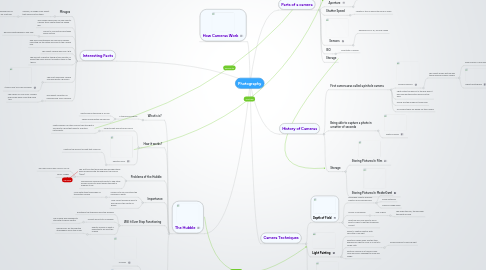
1. The Hubble
1.1. What is is?
1.1.1. A telescope in space
1.1.1.1. Orbits around the world in 97 min
1.1.1.2. Speed of kilometres per second
1.2. How it works?
1.2.1. Collects light and hits main mirror
1.2.1.1. Light bounces off other mirrors then the light is focused to a hole that leads to scientific instruments
1.2.2. Aperture Door
1.2.2.1. Controls the amount of light that comes in
1.3. Problems of the Hubble
1.3.1. The first time the telescope was launched there were problems with the angles of the mirrors (1990)
1.3.1.1. The main mirror was 0.0002 cm off
1.3.1.2. Blurry Images
1.3.2. Was fixed by sending astronauts to add other smaller mirrors to direct where the light is suppose to go
1.4. Importance
1.4.1. Allows us to see and study the universe in depth
1.4.1.1. More detail than telescopes on the earth's surface
1.4.2. Help collect evidence about a black hole in the centre of galaxy
1.5. Will it Ever Stop Functioning
1.5.1. Eventually the telescope will stop working
1.5.2. Cannot be put into a museum
1.5.2.1. The Hubble was designed to stay with its space shuttle
1.5.3. Robotic mission is what's expected to de-orbit the Hubble
1.5.3.1. Remains will fall through the atmosphere and in the ocean
1.6. Discoveries
1.6.1. Cosmos
1.6.2. Direct Proof of Dark Matter
1.6.3. Death Explosions of Massive Stars (Super Nova)
2. How Cameras Work
3. Interesting Facts
3.1. Mirages
3.1.1. Illusions, an image of an object that should not be there
3.1.1.1. Shimmering pool of water on a hot day
3.2. The Hubble Telescope can see objects a billion times fainter than the naked eye
3.3. Almost 2,700 pictures are taken every second
3.3.1. 85 billion photographs in one year
3.4. Red eye in photographs are red blood vessels reflecting off the retina and back to the camera lens
3.5. The oldest camera was from 1816
3.6. The amount of photos taking in two minutes, is almost the same amount of photos taken in the 1800's
3.7. The most expensive camera sold was worth 2.8 million
3.7.1. It was a rare 1923 Leica camera
3.8. The largest collection of cameras hold 4425 cameras
3.8.1. The owner is a man from Mumbai and he has been collecting since 1977
4. Parts of a camera
4.1. Lenses
4.1.1. A transparent piece that bends light to help create an image
4.1.2. Best lenses are made from different types of glass
4.1.2.1. They combine in a way that allows light to refract identically
4.1.3. Chromatic Aberration
4.1.3.1. an effect that causes the image to come out blurry
4.1.4. lenses refract the light
4.1.4.1. if a good quality lens is not used, the lights will refract at different frequencies or ways
4.1.5. Leads light to sensors
4.2. Aperture
4.2.1. controls the amount of light into camera
4.3. Shutter Speed
4.3.1. Length of time in which the lense is open
4.4. Sensors
4.4.1. Replaces roll of fill, records image
4.5. ISO
4.5.1. sensitivity of sensor
4.6. Storage
5. History of Cameras
5.1. First camera was called a pinhole camera
5.1.1. Camera Obscura
5.1.1.1. The oldest known picture was taking using a pinhole camera
5.1.1.1.1. Took 8 hours of sun exposure
5.1.1.1.2. Oldest photograph
5.1.2. Light enters the box but if the box wasn't dark enough the picture would not be seen
5.1.3. Would see the image but soon fade
5.1.4. All camera today are based off this camera
5.2. Being able to capture a photo in a matter of seconds
5.2.1. Digital Camera
5.3. Storage
5.3.1. Storing Pictures In Film
5.3.2. Storing Pictures In Media Card
6. Camera Techniques
6.1. Depth of Field
6.1.1. Technique used to purposly create a blurry background
6.1.1.1. Focal Point
6.1.1.2. Show distances
6.1.1.3. Make an image sharp
6.1.2. Circles of confusion
6.1.2.1. Size of Blurr
6.1.2.1.1. The larger the blur, the narrower the depth of field
6.1.3. Aperture and Lens have to be on point in order to get this technique correct
6.2. Light Painting
6.2.1. Apply to capture photos with very little of no light
6.2.2. Aperture is wide open and the time exposed for light to come in is set at a longer rate
6.2.2.1. Allows sensors to pick up light
6.2.3. Position camera on a tripod in dark room and use a flashlight to draw and image
6.3. Flash Photography
6.3.1. Adding light to natural light
6.3.1.1. Use flashing/Strobes
